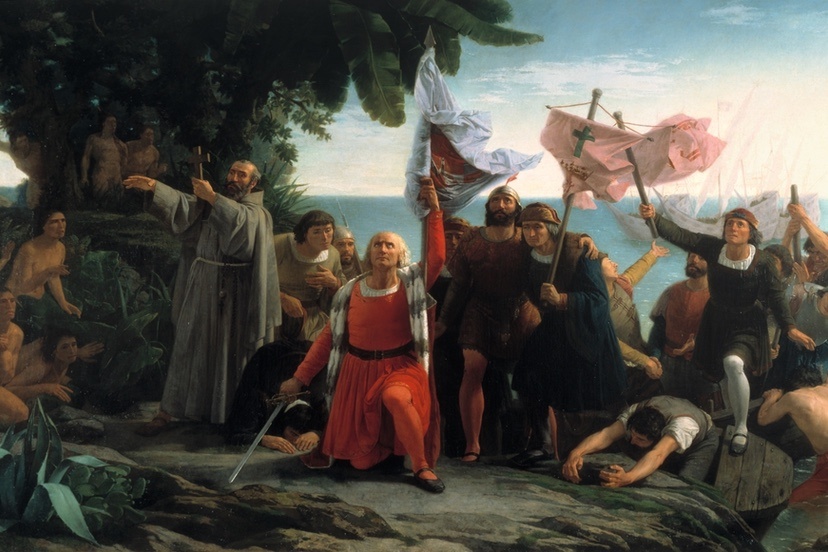Painting: Desembarco de Colón de Dióscoro Puebla, 1862.
In case you didn’t notice, yesterday was Columbus Day.
Which is celebrated as “Italian-American Heritage and Culture Day” in Columbus, Ohio. Perhaps with an emphasis on “Italian.” Columbus Day in America was promoted by various Italian leaders and organizations… was first celebrated in New York City in 1792… and became a federal holiday in 1971.
The rumor was, that Columbus was Italian. And probably, Catholic.
It’s also possible you didn’t notice that Columbus Day is no longer celebrated as a “state holiday” in Colorado. It was “replaced” in 2020 with “Frances Xavier Cabrini Day,” celebrated as a state holiday on the first Monday in October, which this year was October 7.
Frances Xavier Cabrini was also Italian, by birth, so maybe it was a fair exchange. She immigrated to the U.S. in 1889 — legally — and founded the Missionary Sisters of the Sacred Heart of Jesus, a religious institute provided education, health care, and other services to orphans and the poor — many of whom were Italian.
For some reason, “Frances Xavier Cabrini Day” didn’t appear on my Google calendar, so I totally missed celebrating it.
Historians have generally held the belief that Christopher Columbus was of Italian descent, although his explorations of the Western Hemisphere were financed mainly by Queen Isabella of Spain.
But “Christopher Columbus” was probably not his real name. In Spain, he’s known as Cristobal Colón, and in Italy, his name is Cristoforo Colombo.
As of this past Saturday, it appears that he also wasn’t Italian. Or Catholic.
Spanish television aired a documentary on October 10: Colón ADN. Su verdadero origen. “The DNA of Columbus: His true roots.” (“DNA” is “ADN” in Spanish.)
Researchers, led by forensic pathologist José Antonio Lorente, examined microscopic samples of remains buried in Seville Cathedral — believed to be the remains of Cristobal Colón — and compared that DNA to the DNA of his known relatives and descendants, including his son Hernando. The DNA study provided evidence that the remains of Christopher Columbus — or whatever his name was — are indeed buried in Seville.
According to the analysis, Cristobal Colón was a Spanish, or Sephardic, Jew. (I understand the word “Sephardic” comes from “Sefarad”, the Hebrew word for “Spain”.)
“The outcome is almost absolutely reliable,” Dr. Lorente said. If only that could be said about all scientific research.
The researchers apparently had two key goals in mind. First, to prove that the remains in Seville Cathedral belonged to someone related to Colón’s known descendants, and second, to prove that Colón was Spanish, rather than Italian.
Spain hasn’t had much going for it these days, other than tourism — they lost control of their colonies in North and South America during the 1800s — so I imagine being able to claim Columbus as a native son must feel really good, right about now.
“We have DNA from Christopher Columbus, very partial, but sufficient. We have DNA from Hernando Colón, his son,” Dr. Lorente said in the documentary. “And both in the Y chromosome [male] and in the mitochondrial DNA [transmitted by the mother] of Hernando there are traits compatible with Jewish origin.”
Approximately 300,000 Jews resided in Spain before Catholic monarchs Isabella and Ferdinand ordered Jews and Muslims to convert, or face exile. The expulsion of Jews from Spain took place in 1492, the same year as Columbus’ first voyage.
Sounds like maybe he got out of the country just in time.
In 2020, the Colorado General Assembly approved HB20-1031, which established “Frances Xavier Cabrini Day” as a state holiday, and repealed Columbus Day. The law states, in part:
(b) Although Christopher Columbus is recognized as a voyager who arrived in what is now known as the Caribbean Sea, he never traveled to or entered the territory that became the United States. He had no knowledge of or contact with the area now known as the state of Colorado, providing no rationale for a Colorado state holiday in his name. In 1492, he was welcomed by the indigenous Taino people to their homeland on the island of Quiqueya, which Columbus renamed Hispaniola. Fifty years later, the Taino people had been nearly exterminated by Columbus and his successors.
(c) Frances Xavier Cabrini was a humanitarian champion of immigrants and children in the United States. Cabrini first came to Colorado in 1902. In 1905, she opened the Queen of Heaven Orphanage for girls in a residence in north Denver.
(d) In her lifetime, Cabrini was responsible for founding sixty-seven institutions, including schools, hospitals, and orphanages throughout the United States and in South and Central America.
Which just goes to show, if you want to be celebrated in Colorado, you’re better off starting an orphanage, than committing mass murder.
Underrated writer Louis Cannon grew up in the vast American West, although his ex-wife, given the slightest opportunity, will deny that he ever grew up at all. You can read more stories on his Substack account.

